What Is a Dotwork Tattoo?

Dotwork tattoos are a striking fusion of art, geometry, and technique — a style built entirely from thousands of carefully placed dots rather than continuous lines or traditional shading. Instead of relying on bold outlines or color gradients, dotwork tattoos create depth, texture, and dimension through patterns of ink dots spaced at varying densities. The result is a visually hypnotic effect that can feel both minimalist and complex at once.
But dotwork isn't just about aesthetics — it’s about intention. Each dot is a precise choice, building up a design layer by layer in a meditative, almost ritualistic process. Artists use this technique to form intricate mandalas, sacred geometry, optical illusions, nature-inspired pieces, and surreal abstract work.
This style has roots in ancient tribal practices, but its modern resurgence is closely linked to the fine art technique of pointillism — a painting style from the 19th century where tiny dots of color formed entire scenes. Today, dotwork tattoos blend that fine art tradition with cutting-edge machine control and a refined sense of design, appealing to both tattoo minimalists and collectors of detailed blackwork alike.
While dotwork may appear delicate, the precision it requires makes it one of the most technically demanding forms of tattooing. That’s why both the artist’s skill and the quality of the equipment play a huge role in achieving crisp results that stand the test of time.
The History Behind Dotwork Tattoos
The origins of dotwork tattoos stretch back centuries, rooted in ancient tribal traditions where patterns and symbols were hand-poked into the skin using basic tools. These early forms of body art, found in cultures across Polynesia, Southeast Asia, and Indigenous America, used dot-based techniques not only for decoration but also for storytelling, protection, and spiritual meaning.
Fast forward to the 19th century, the fine art movement known as pointillism laid the groundwork for dotwork’s modern aesthetic. Artists like Georges Seurat and Paul Signac used thousands of individual dots to form intricate paintings — an approach that has since crossed over into tattooing. Today, dotwork tattoos often carry a similar meditative quality and a strong connection to symbolism, geometry, and minimalism.
This blend of historical ritual and modern artistry gives dotwork a timeless appeal. It’s not just a style — it’s a language made of dots, each one placed with purpose. Whether you’re drawn to its visual symmetry or its spiritual undertones, dotwork tattooing remains one of the most meaningful techniques in the tattoo world.
Dotwork Tattoo Technique Explained
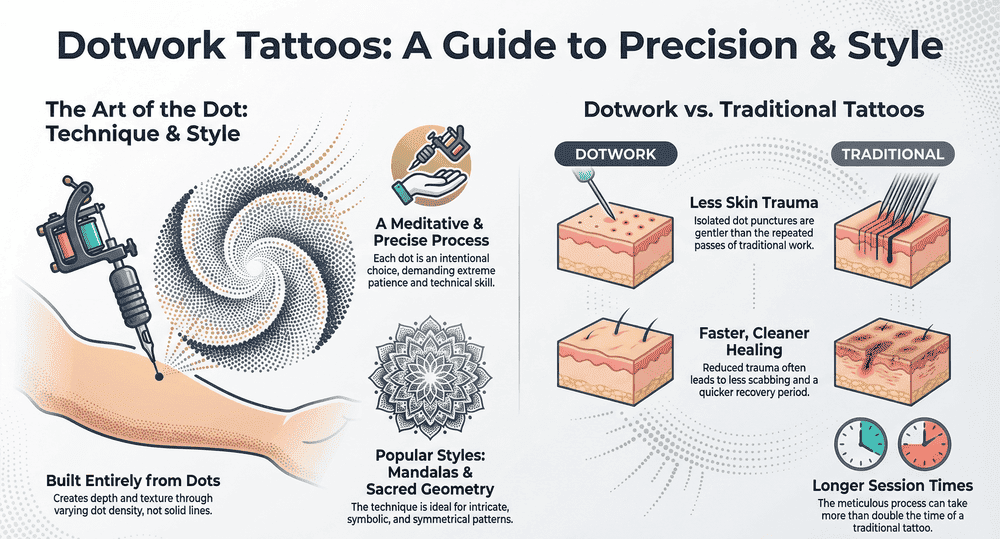
At its core, dotwork is all about precision. Instead of using solid lines or color blocks, the artist builds up an image by applying countless individual dots. The closer the dots are placed together, the darker the area appears; the more spaced out they are, the lighter the tone. This method allows for incredibly smooth gradients, subtle textures, and a soft, almost three-dimensional look.
Dotwork tattoos can be created using either a hand-poke technique or a rotary tattoo machine with fine or single-needle cartridges. While hand-poking offers an ultra-traditional approach, most modern artists rely on pen-style machines that offer both control and efficiency over long sessions.
Machines like the Ultron 3 are ideal for this level of detail. Its ergonomic design, ultra-low vibration, and lightweight feel allow artists to maintain consistency throughout intricate work — especially in large-scale dot shading or geometric pieces. With the right tool, the artist can focus entirely on dot placement without muscle fatigue or loss of precision.
Mastering the dotwork tattoo technique takes more than just equipment. It requires patience, rhythm, and a deep understanding of how to translate density into tone — how each individual dot contributes to the overall design. When done well, the result is a composition that feels as much like fine art as it does body art.
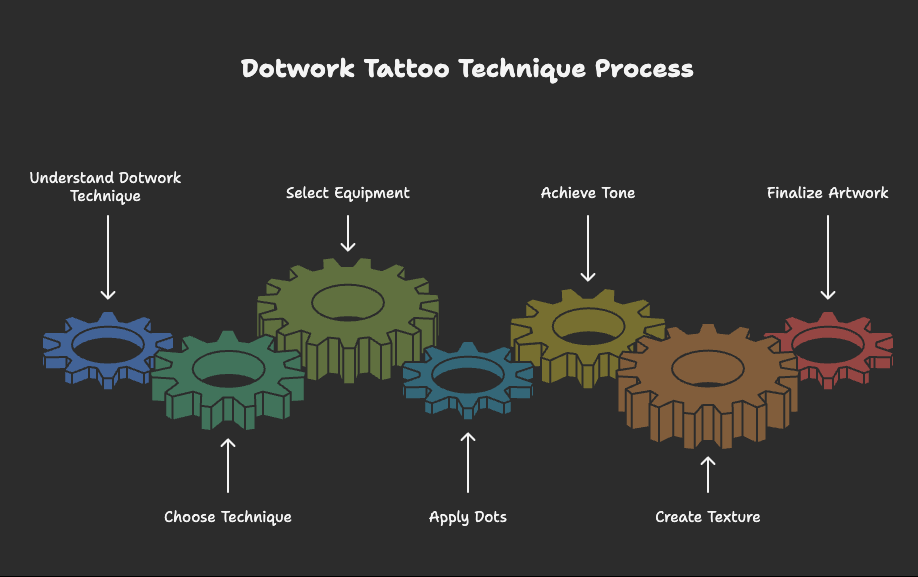
Popular Dotwork Designs and Styles
Dotwork tattoos offer a unique visual language, making them a favorite among artists who want to push creative boundaries. Because the technique focuses on density and spacing rather than color, it lends itself especially well to symbolic, geometric, and abstract compositions.
One of the most recognizable forms is the mandala — a circular design rooted in spiritual traditions, made even more hypnotic through layered dot patterns. Geometric dotwork tattoos often feature symmetry, sharp angles, and repetition, transforming the body into a canvas of balance and precision. These designs aren’t just visually appealing; they often carry deep meanings tied to harmony, transformation, and the universe itself.
Nature-inspired designs are also common, with dot gradients used to replicate textures like fur, feathers, or stone. Some artists blend dotwork with realistic portraiture or surrealism, creating hybrid tattoos that feel both structured and organic. Others take a minimalist approach, using just a few hundred dots to form a subtle but powerful image.
Dotwork tattoos tend to avoid color, favoring black or grey ink for clarity and longevity. In some cases, however, artists combine dotwork with other tattoo styles — such as fine lines, stippling, or even traditional bold outlines — to create striking contrasts. This versatility is part of what has made dotwork so popular in recent years, especially among clients looking for something meaningful, meditative, and visually refined.
Dotwork vs Traditional Tattoo Styles
While traditional tattoo styles rely on bold lines, solid fills, and vibrant colors, dotwork takes a completely different approach. It replaces saturation with subtlety, using thousands of tiny ink dots to build images that feel soft, detailed, and organic.
One of the most noticeable differences is the trauma to the skin. Traditional tattoos often require multiple passes over the same area to pack in color or create solid blackwork, which can increase skin irritation and prolong healing. Dotwork tattoos, by contrast, use a lighter touch — each dot is an isolated puncture, which tends to be less painful and gentler on the skin, especially during long sessions.
That said, dotwork isn’t necessarily painless. Because the designs are made up of countless individual dots, the process can be time-consuming. A medium-sized mandala tattoo that might take two hours in a traditional style could take four or more using dotwork technique. For many artists, a high-precision machine is essential to keep the process smooth and consistent — and that’s where tools like the Ultron 4 Pro stand out. With customizable stroke settings and ultra-stable performance, it allows artists to shift between soft shading and detailed line-based dotwork effortlessly.
Healing time can also differ. Dotwork tattoos tend to produce less scabbing and redness due to reduced skin trauma, often resulting in a faster and cleaner recovery. For clients concerned about comfort, placement, or long-term results, dotwork may offer a more forgiving alternative to traditional styles — without sacrificing visual impact.
Best Tattoo Machines for Dotwork
Because dotwork demands exceptional control and endurance, choosing the right tattoo machine can make or break the result. Artists need tools that deliver consistency, low vibration, and the flexibility to handle fine detailing over long sessions.
The Avenger 3 Pro is a standout for artists who want versatility without sacrificing precision. With six adjustable stroke lengths and a responsive M3Pro motor, it adapts quickly to the varying needs of dotwork — from bold gradients to feather-light patterns. This makes it perfect for large-scale compositions where the artist must shift between dot densities mid-session.
For those who prioritize a lighter feel, the Ultron 3 delivers maximum control with minimal hand fatigue. Its low-resistance design and wireless setup make it a go-to for intricate pieces like mandalas, sacred geometry, or minimalist dot arrangements. When every dot counts, maintaining hand stability is key — and this machine supports exactly that.
Precision also depends on stroke regulation. That’s where the Ultron 4 Pro truly shines. With a smart stroke control system and ultra-fine motor calibration, it’s ideal for layering consistent dots with minimal skin trauma. Its SmartHit feature allows the artist to adjust hit softness, making it an excellent option for sensitive areas or extended sessions.
Artists who want to refine their technique before applying it to skin can also benefit from the DotWorker — a specialized accessory that allows for off-skin dotwork training. Practicing stroke control, rhythm, and consistency outside of client sessions helps artists master the flow needed for flawless execution.
Tips for Getting a Dotwork Tattoo
Whether you're an artist preparing to offer dotwork or a client considering your first piece, understanding the process and preparation can make all the difference. Dotwork tattoos require more than just patience — they demand intention, both technically and creatively.
Start with placement. Areas like the forearm, calf, or upper back are ideal because they offer a flat surface and enough space for complex patterns. More sensitive spots like ribs or ankles can amplify discomfort, even though dotwork is generally less painful than traditional styles. Still, every body reacts differently, so it’s important to communicate clearly with your tattoo artist.
Next is preparation. Before your session, make sure to hydrate, get a full night’s sleep, and eat a solid meal. Avoid alcohol and blood-thinning medications. These steps help regulate your body and make long sessions more manageable.
Machine setup plays a vital role, too. If you're an artist, check out this step-by-step machine setup guide to ensure you're working cleanly and efficiently. Since dotwork involves repetitive micro-movements, tuning your equipment for optimal stroke and minimal resistance is essential.
Finally, aftercare is simple but crucial. Keep the area clean, avoid sun exposure during healing, and resist scratching. Dotwork tattoos tend to heal faster with fewer complications, but only if treated with care. And remember: because the designs rely on contrast and clarity, preserving every dot counts.
FAQ About Dotwork Tattoos
1. Do dotwork tattoos last as long as traditional tattoos?
Yes — when applied properly, dotwork tattoos can be just as permanent as traditional tattoos. However, since they rely on negative space and fine dot distribution, fading may occur faster if aftercare isn’t followed. To preserve clarity, avoid excessive sun exposure and moisturize regularly. Placement also matters — areas like the rib or shoulder may experience more distortion over time.
2. Can dotwork tattoos be combined with other tattoo styles?
Absolutely. Dotwork is often integrated into hybrid designs — for example, linework and stippling, or bold black outlines combined with soft dot gradients. This contrast makes the composition more dynamic and versatile. Artists also use dotwork to enhance realistic or abstract tattoos, creating texture and atmosphere.
3. What should I consider before getting a dotwork tattoo?
Before getting a dotwork tattoo, think about the design's complexity, size, and body area. While minimalist designs heal quickly, intricate patterns may require multiple sessions. Be sure to find a tattoo artist who specializes in dotwork and can explain how the technique will work with your skin type.
Conclusion
Dotwork is more than just a tattoo style — it’s a philosophy of patience, precision, and purposeful design. Built dot by dot, this technique transforms skin into a canvas of texture, symmetry, and symbolism. Whether you're drawn to its minimalist appeal, spiritual roots, or hypnotic geometry, a well-executed dotwork tattoo is a timeless statement of craftsmanship.
Unlike styles that rely on color or bold lines, dotwork speaks in gradients and negative space. It invites the viewer in for a closer look — and rewards that attention with depth and detail. For artists, it offers a meditative process that emphasizes control and intentionality. For clients, it offers unique aesthetics and often a gentler healing experience.
If you’re ready to explore this technique, invest in tools built to handle its complexity. Machines like the Ultron 3 Pro and others featured in our best tattoo machines guide provide the consistency and performance needed to elevate your dotwork to its highest potential.
Dot by dot, line by line — this is tattooing at its most focused. And for those who master it, dotwork opens the door to designs that are as meaningful as they are mesmerizing.

 Custom Ultron 4 Pro
Custom Ultron 4 Pro
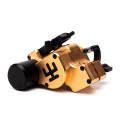 Custom Avenger 3 Pro
Custom Avenger 3 Pro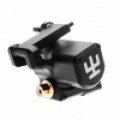 Avenger 2 Pro Series
Avenger 2 Pro Series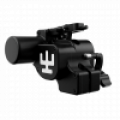 Avenger 3 Pro Series
Avenger 3 Pro Series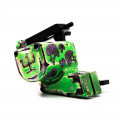 Custom Avenger 2 Pro
Custom Avenger 2 Pro